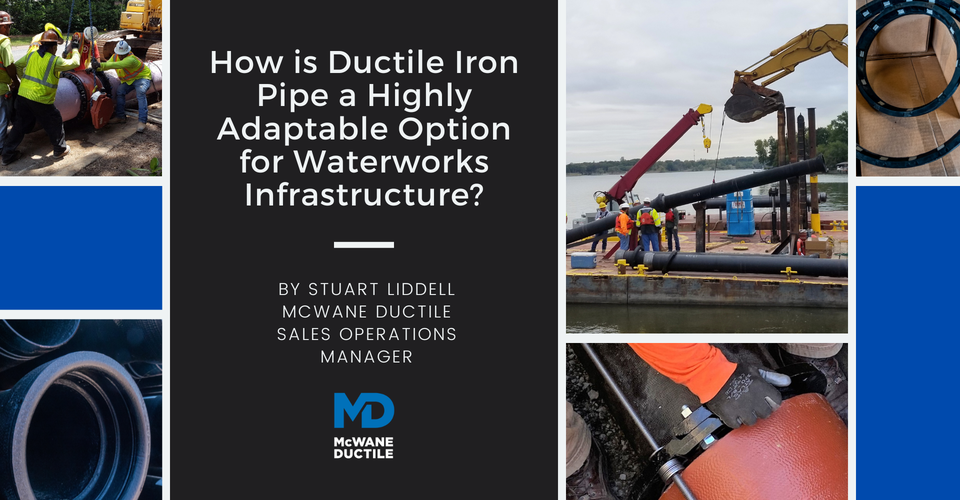As a Sales Operations Manager in the waterworks industry, I recently attended the American Water Works Association's Annual Conference and Exhibition (ACE24) in Anaheim, California. This annual conference focuses on product innovations and the latest technological advancements in water infrastructure.
While at the ACE Conference, I was impressed by the dedication of utility authorities, engineers, and manufacturers toward improving water quality and management. Different materials like PVC, HDPE, RCP, Steel, and Ductile Iron are used for water pipelines, each with its own advantages. However, Ductile iron pipe (DI pipe) stands out for its strength, corrosion resistance, and adaptability in various installation scenarios. On-the-fly layout changes during pipeline installations are simplified with Ductile iron pipe, fittings, and accessories.
Although Ductile iron pipe has been around for many decades, it has continued to evolve, ensuring even greater dependability for the end user. This #IronStrong Blog outlines key points about DI pipe's adaptability for pipeline installations.
How has joint technology allowed Ductile iron pipe to adapt to various pipeline installations?
Ductile iron restrained joint technology advancements have enabled a broader range of installation techniques and applications. Modern proprietary designs are solid and durable. Consequently, these restrained joints have been incorporated into evolving installation practices, such as Horizontal Directional Drilling (HDD).
DI pipe is well-suited for HDD installations due to its durability and capacity to withstand the stresses of underground installation. Telcom and other utilities have utilized HDD installation for some time before it was considered for water and wastewater installations. This mainly involved fused or welded products in plastics or steel. However, the flexibility and resiliency that DI restrained joints offer made it a viable candidate for this type of installation. From the early 1990s, countless successful HDD installations have used boltless DI restrained joint products such as TR Flex™ Restrained Joint Pipe. These installations range from relatively short crossings underneath roadways to much longer installations under rivers or lakes without visual or structural effects on the surfaces or environments above.
How has Ductile iron pipe been adapted to hazard-prone areas?
Another area where the strength and resilience of Ductile iron pipe made for easy adaptation was in seismic or earthquake-prone regions. Again, current DI restrained joint technology was already a proven product in many of these regions. Still, continued innovation has led to an even more resilient design with Earthquake-Resistant Ductile Iron Pipe (ERDIP).
Most Ductile manufacturers now have ERDIP products made specifically for this application, which is the preferred material. Again, the primary reason is the strength and durability of Ductile iron, but new products, such as the Seismic Flex Coupling™, offer even more impressive results regarding expansion and contraction and increased deflection capabilities. These qualities allow the pipe to withstand tremendous ground movement without concern for breaks or separation.
How have Ductile iron gaskets improved product adaptability?
When discussing a product such as an iron pipe that has been used for over two centuries, restrained or “locking gaskets” are another relatively new adaptation. Locking gaskets, such as the Sure Stop 350 Gasket™, improve the flexibility and adaptability of Ductile iron pipe in water pipeline installations. Easy to install, these innovative materials allow the pipe to accommodate ground movement, thermal expansion, and contraction without compromising the seal or structural integrity. Add to this the various elastomers for which gaskets can be provided; then, there is virtually no installation where the DI pipe cannot be adapted to the environment in which it will be installed.
How do various linings expand the capabilities of Ductile iron pipe?
Ductile iron pipe offers lasting versatility in water and sewer pipelines through various linings and coatings tailored to numerous operational requirements. The first recorded use of cement-mortar linings in iron pipes was in 1922. Portland cement-mortar linings provide an excellent physical barrier to prevent the buildup of flow-reducing tuberculation in unlined pipes. Recent flow tests have shown that cement-mortar linings maintain their smooth hydraulic characteristics for potable water systems for many decades, some as much as 100 years or more of continual service.
For highly abrasive or aggressive fluid transport, such as sewage or chemical lines, ceramic-modified amine-cured novolac epoxies have evolved to be a reliable option in internal and external protection of the underlying Ductile iron pipe surfaces. Some of these advanced epoxies also carry the NSF-61 certification, permitting their use in raw to potable water systems. Where elevated service temperatures are present in aggressive fluid pipelines, glass lining can enhance durability and abrasion resistance. These epoxies and glass options take well to Ductile iron; no glue is required.
How do various coatings increase the capabilities of Ductile iron pipe?
While it is typical for Ductile iron pipe to be supplied with a stand-alone asphaltic coating, it can also be provided or installed with external protection for extreme installations with various coating options. For example, if soil conditions merit further protection, a coating or wrap such as V-Bio® Enhanced Polyethylene Encasement may be recommended. V-Bio® protects against anaerobic bacteria and inhibits corrosion cells, extending the pipe's service life.
Along with V-Bio, the specifier may also consider adding zinc coating to create a protective zinc oxide dielectric barrier. Zinc by-products, which are left behind after reacting in aggressive soils, form a healing protective barrier that helps mitigate further corrosion, extending the pipes’ service life. Another level of protection may include a product such as Ceramawrap, a solvent-free, fast-curing two-component epoxy that protects DI pipe in aggressive atmospheres like saltwater.
Before selecting any of these options, the responsible person should consult the Design Decision Model (DDM). The DDM is an easy-to-use guiding matrix of common variables that mutually examines the likelihood and consequences of adverse potential upon your pipeline and points to the recommended level of protection, from nothing required in many cases to polyethylene wrap encasement, bonded joints, or full-on cathodic protection.
How have the manufacturing principles of Ductile iron pipes been adapted to electric utility poles?
McWane Ductile has adapted its manufacturing principles and techniques from Ductile iron pipe to create Ductile iron electric utility poles. This evolution has dramatically enhanced our electrical powerline infrastructure's strength, durability, fire resistance, and critical hardening. Ductile iron's superior innate properties make it an ideal material for utility poles exposed to harsh environmental conditions, ensuring long-term reliability and structural integrity … even against hurricanes.
Incorporating many additional features, such as customized pre-drilled cable or attachment holes and connectors, enhanced coatings for corrosion protection, and aesthetic finishes, make Ductile iron utility poles a modern wonder of performance and endurance.
How can Ductile iron pipe adapt to your waterworks project?
This blog has touched on key points addressing the adaptability of Ductile iron pipe for infrastructure needs. DI pipe's ability to adjust to match different installation conditions is unparalleled. I proudly represent DI pipe and its crucial role in maintaining safe and reliable water delivery systems. If you have questions or want to learn more about Ductile iron pipe for your water or wastewater infrastructure projects, contact your McWane Ductile representative. Many of our team members have managed small and large water utility systems, served in engineering consulting firms, and bring decades of experience solving field issues involving pipeline construction and operation. From design to submittal to installation, we strive to educate and assist water professionals throughout the water and wastewater industry.







